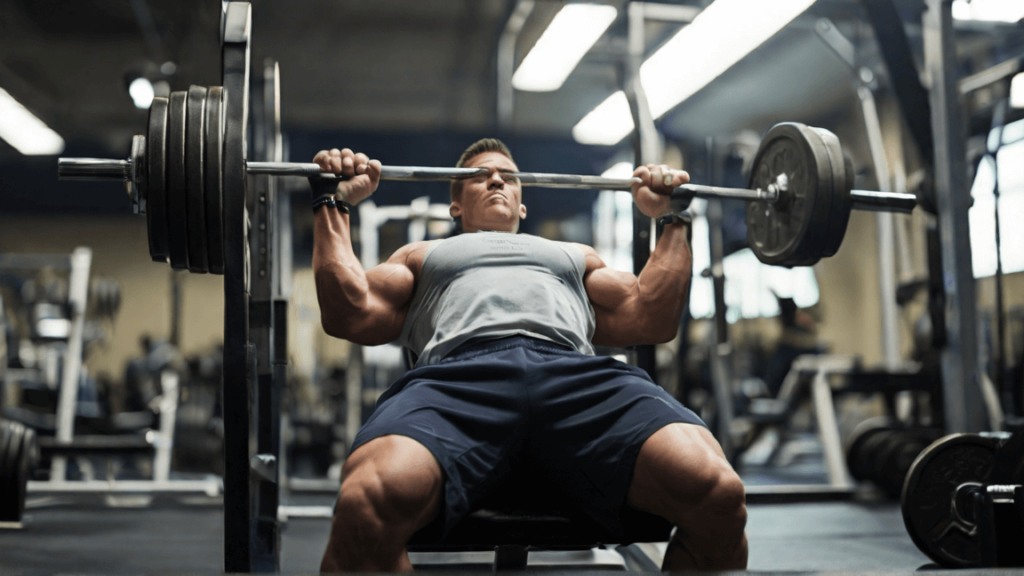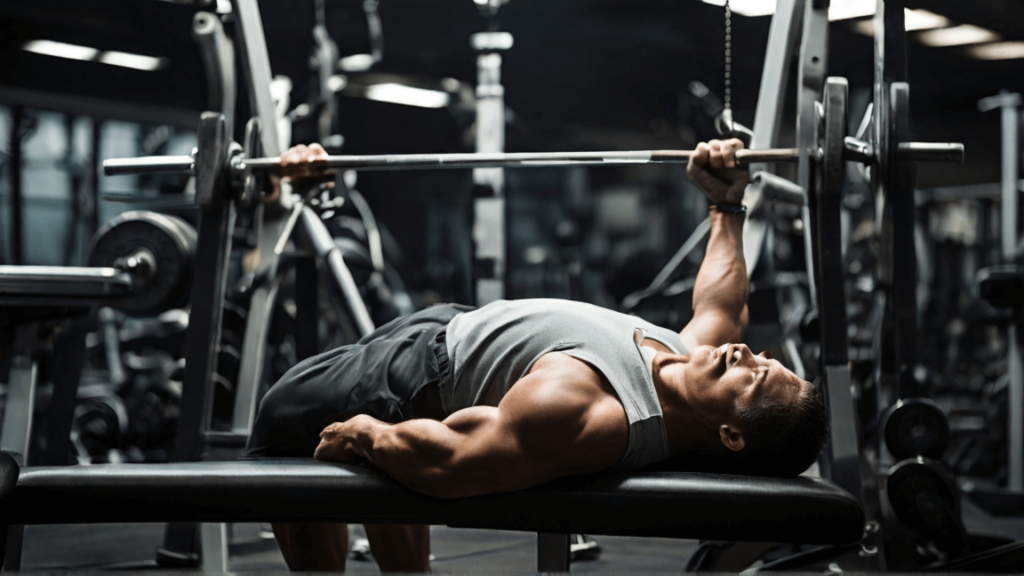Introduction:
It might be hard to find time to work out in the fast-paced world of today. But you may have a satisfying exercise routine in the comfort of your own home if you have the correct tools and a little inventiveness. A basic bench may be an effective tool for a range of workouts, focusing on various muscle groups and assisting you in reaching your fitness objectives. We’ll look at 12 efficient bench workouts in this post that you may use for at-home training.
Without the need for pricey gym memberships or specialized equipment, these exercises provide a quick and effective approach to keep in shape, whether your goals are to gain strength, increase muscle mass, or improve endurance. Let’s get started and learn how to use these bench exercises to get the most out of your at-home.
1. Bench Press

A fundamental exercise for strengthening the upper body, the bench press works the triceps, shoulders, and chest. You may work many muscle groups at once by lowering the weight to chest level and then pushing it upward while reclining on a bench with a barbell or dumbbells extended and your arms relaxed. Increasing the total strength and muscular mass of the upper body requires this complex exercise.
A well-rounded exercise regimen is ensured by variations like incline and decline bench presses, which allow for the targeting of particular chest regions. Bench presses improve muscle definition and help build functional strength for daily tasks when included in a home training program. For home workouts here are the Top 15 Exercise Machines for Weight Loss.
2. Incline Bench Press

An adaptation of the traditional bench press that works the muscles in the upper chest is the incline bench press. You may change the emphasis on the clavicular head of the pectoralis major by tilting the bench to a position that is between 15 and 30 degrees incline. This variant gives your entire body equilibrium and aids in the development of a well-rounded chest. Exercises like incline bench presses work the shoulders and triceps in addition to strengthening the upper chest.
You may improve both the appearance and functional strength of your upper body by including this exercise in your at-home training regimen. For those looking to gain size and shape to their muscles, incline bench presses are a great complement to any training program.
3. Decline Bench Press

Another form of the bench press that works the muscles in the lower chest is the decline bench press. You highlight the pectoralis major’s sternal head by lowering the bench to an angle of around 15 to 30 degrees. This version gives the chest muscles a special challenge that aids in the development of lower chest strength and definition. Look for the 12 Effective Bench Exercises for Home Workouts.
Decline bench presses are a good upper body complex workout since they also somewhat work the shoulders and triceps. Including this exercise in your at-home fitness regimen guarantees thorough chest muscle growth while also adding variation. Decline bench presses are a great addition to any trainer’s repertoire, whether your goal is to increase overall chest strength or improve muscular symmetry.
4. Dumbbell Flyes

One type of isolation exercise that works the muscles mostly in the chest area is the dumbbell fly. You make a broad arc motion with the dumbbells in your hands, arms outstretched, and palms facing inward while reclining on a flat bench. This brings the weights together over your chest. The chest muscles are stretched and contracted during this exercise, which encourages muscular growth and definition. Exercises like dumbbell flyes are a good approach to target the chest without overusing other muscles. They contribute to the enhancement of the chest’s attractive appeal by promoting better muscular balance and symmetry.
Dumbbell flyes are a great addition to complex exercises like bench presses for a full-body workout that targets the chest. Dumbbell flyes are a versatile and effective way to achieve your fitness objectives, whether your goal is to define your chest muscles or gain bulk.
5. Bench Dips

A bodyweight exercise that works the shoulders, chest, and triceps is the bench dip. Bench dips include placing your hands on a bench’s edge with your fingers pointing front, bending your elbows to lower your body until your upper arms are parallel to the floor, and then pushing yourself back up to the beginning position. This exercise stabilizes the body by using the shoulders and chest. Also, read the list of Top Massage Machines for you.
In addition to properly using the triceps. By adjusting the distance between your feet and the bench or by selecting a lower surface for a greater challenge, you may modify bench dips to suit varying fitness levels. Adding bench dips to your at-home exercise regimen can help you improve your upper body overall by strengthening and toning your triceps.
6. Bulgarian Split Squats

One lower body workout that works the quadriceps, hamstrings, and glutes is the Bulgarian split squat. Bulgarian split squats are performed by raising one foot behind you in front of a bench, lowering your body by bending your front knee until your thigh is parallel to the floor, and then pushing yourself back up to the beginning position.
This exercise efficiently works one leg at a time while testing stability and balance. By elevating the exercise using a bench, you may improve its range of motion and intensity, which will promote better muscle growth and activation. To increase lower body strength, stability, and muscular symmetry, you may include Bulgarian split squats into your at-home training regimen. This exercise is adaptable and ideal for all fitness levels.
7. Step-Ups

Step-ups are a vigorous lower body workout that works the glutes, hamstrings, and quadriceps. Step ups are as follows: choose a position in front of a bench or raised platform, plant one foot there, push through your heel to raise your body until your leg is straight, and then carefully lower yourself back down. This workout strengthens the lower body muscles and enhances coordination and balance.
You may change the exercise’s difficulty to meet your fitness level by modifying the height of the bench or platform. Step-ups are a great complement to any at-home exercise program that focuses on lower body strength and stability since they are an efficient technique to strengthen the legs and enhance functional movement patterns. Explore our selection of Exercise Machines for Weight Loss to help you achieve your fitness goals.
8. Bench Rows

Bench rows are a type of compound exercise that mainly works the latissimus dorsi, rhomboids, and trapezius muscles in the back. Bench rows are performed by lying face down on a bench with your feet flat on the floor, your chest supported. Using an overhand grip, grab dumbbells or a barbell, and draw the weight towards your body by bending your elbows and retracting your shoulder blades.
By using the back muscles to lift the weight against gravity, this exercise develops strength and muscular mass. Bench rows are a great technique to strengthen your upper back, boost your pulling actions in daily life, and improve your posture. Bench rows can help you accomplish a well-rounded upper body exercise and balanced muscular growth when incorporated into your at-home training regimen.
9. Tricep Bench Dips

Bench dips are a type of bodyweight exercise that work the triceps mainly, with the shoulders and chest being worked as a secondary muscle. With your legs stretched in front of you and your hands behind you with your fingers pointing forward, you may execute tricep bench dips while sitting on a bench edge.
Once your upper arms are parallel to the ground, lower your body by bending your elbows and push yourself back up to the beginning position. By isolating the triceps, this exercise successfully tones and strengthens the rear of the arms. You may change the difficulty of tricep bench dips to meet your own fitness level by modifying the distance you stand between the bench and your body or by utilizing a lower surface.
10. Single-Leg Bench Squats

One unilateral lower body exercise that works the quadriceps, hamstrings, and glutes while simultaneously testing balance and stability is the single-leg bench squat. Standing in front of a bench with one foot raised slightly off the floor, lower your body by bending your standing knee until your thigh is parallel to the floor, then push yourself back up to the starting position to complete a single-leg bench squat. This exercise emphasizes one leg at a time while imitating the form of a regular squat.
You may improve the exercise’s range of motion and intensity, which promotes higher muscular activation and growth, by employing a bench for support and elevation. One of the best ways to increase lower body strength, stability, and muscular symmetry is with single-leg bench squats.
11. Bench Leg Raises

Bench leg lifts are an exercise that strengthens the core and works the hip flexors and lower abdominals. Lay flat on your back on a bench with your legs outstretched and your hands supporting yourself on the borders to perform bench leg lifts.
Raise your legs until they are perpendicular to the floor, then carefully drop them back down while maintaining pressure on your lower back against the bench. By isolating the lower abdominal muscles, this exercise efficiently increases the region’s strength and definition. You can maximize the effectiveness of the workout by maintaining good form throughout by using a bench for assistance.
12. Seated Shoulder Press

A basic upper body exercise that works the shoulder deltoid muscles is the seated shoulder press. For this exercise, take a seat on a bench with your back supported, and use your overhand grip to hold a barbell or dumbbell at shoulder height. Lift the weights until your arms are fully extended over your shoulders, then carefully lower them back down to shoulder level.
Through efficient shoulder strengthening, this exercise enhances shoulder stability and the strength of overhead pressing. The seated position also reduces momentum, which guarantees good form and lowers the possibility of damage. Including sitting shoulder presses in your at-home exercise regimen will help you build stronger, more functional movement patterns, and well-rounded shoulder muscles.
Conclusion:
To sum up, adding bench exercises to your at-home fitness regimen is a practical and efficient approach to work your entire body. Because of its adaptability, bench exercises can be used to fully train a variety of muscular groups, regardless of your goals: strength, muscle mass, or endurance. With a variety of options to meet varying fitness levels and goals, there is a vast selection of exercises available, from traditional ones like the bench press to dynamic motions like Bulgarian split squats.
Strength, muscular definition, and general fitness can all be improved by regularly completing these exercises with the right form and technique. To get the best results, always pay attention to your body, increase weight and intensity gradually, and give rest and recuperation top priority.
FAQ,s
How many sets and repetitions should I do for each exercise?
Aim for 3-4 sets of 8-12 repetitions for each exercise to promote muscle growth and strength development
Can I use household items as substitutes for weights?
Yes, you can use water bottles, backpacks filled with books, or canned goods as makeshift weights for resistance training.
How often should I incorporate these bench exercises into my routine?
Perform these exercises 2-3 times per week with at least one day of rest in between to allow for muscle recovery and growth.
I’m a beginner. Are these exercises suitable for me?
Yes, many of these exercises can be modified for beginners by adjusting the weight or range of motion. Start with lighter weights and gradually increase as you build strength and confidence.
Can I do these exercises without a bench?
While a bench is ideal, you can modify some exercises by using a stable chair or step stool for elevation. However, for optimal results, investing in a bench is recommended.

